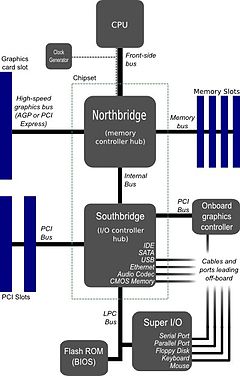Introduction to Computers
Motherboard [src]Introduction to the motherboardYou may choose to click on the images to the right and explore what amotherboard looks like in more detail, but our primary emphasis is just what it does. Besides, motherboards do not all look alike. (Compare to image below.) It's a bit like lifting the hood on your car. You don't have to be a mechanic to know where to add windshield washer fluid. One of my goals is simply to take the mystery out of all that "stuff". It would be useful to open an old desktop PC just to actually see the parts. While I don't recommend this with a laptop or hand-held device, the concepts are pretty much the same. That goes for servers, mainframes and supercomputers, as well.We will talk about a few things you might do yourself to upgrade your computer in the last section of this module. Simply looking inside your computer can tell you if you have an open bay to add another hard disk and if you can add memory (or have to replace it). A motherboard is an electronic circuit board in a computer which interconnects hardware devices attached to it — which is to say, all of the system hardware. At a minimum it includes one or more Central Processing Units (CPU), and the main processing activity of the computer takes place on it. However, other connected printed circuit boards may contain their own pre-processing or post-processing CPUs, to take some of the load off of the motherboard; these, together with other plug-in boards without CPUs, may be called "daughter boards". It was called a "mother" board in relation to these. A PC motherboard generally has a series of slots, allowing daughter boards to be plugged in directly. Other connectors on the motherboard allow communication through cables with various peripheral devices, both inside and outside the computer case. |  Labeled diagram of Acer motherboard. Moxfyre at en.wikipedia [CC-BY-SA-3.0 or GFDL], from Wikimedia Commons  Logical layout of a motherboard By en:User:Moxfyre (Image:Motherboard_diagram.svg) [GFDL or CC-BY-SA-3.0], via Wikimedia Commons | |
 An ATX computer motherboard with labeled parts. German Wikipedia user Appaloosa [GFDL or CC-BY-SA-3.0], via Wikimedia Commons | ATX motherboard legend1. Processor socket
2. Chipset
3. RAM slots
4. AGP graphic card slot
5. PCI slots
6. CNR modem slot
7. Audio chip
8. I/O chip
9. BIOS
10. ATX power connector
11. Floppy drive connector
12. ATA connectors
13. Connectors for buttons,
indicator lights etc.
The external ports (connections) are along the top edge (right hand side). A face-on view is shown below. | |
Recommended! (despite the lousy sound track) | ||
PortsPorts are used by a motherboard to interface with electronics both inside and outside of the computer. Integrated ports are those that are part of, directly wired to, the motherboard. Internal integrated ports are used to connect devices inside the system unit. Externalports may be connected to the motherboard directly (integrated) or by circuit boards that are inserted into slots on the motherboard. It is often possible to add new external ports by inserting such a circuit board into an open slot. The external integrated ports are generally grouped together as shown below. Expansion card ports are arranged in a row of equal sized rectangular slots (see graphics/video and network cards below). | ||
800.jpg) | ||
No comments:
Post a Comment